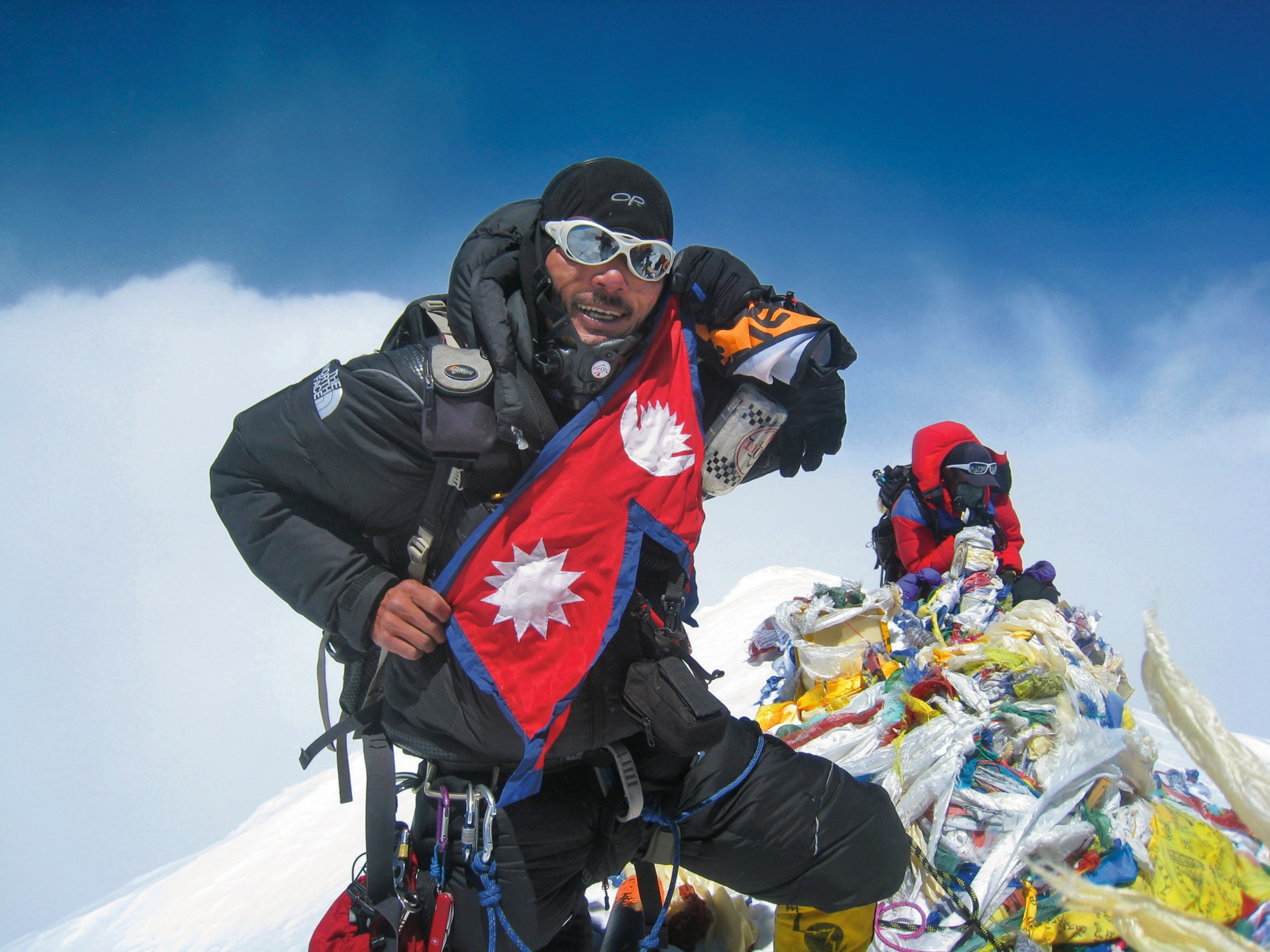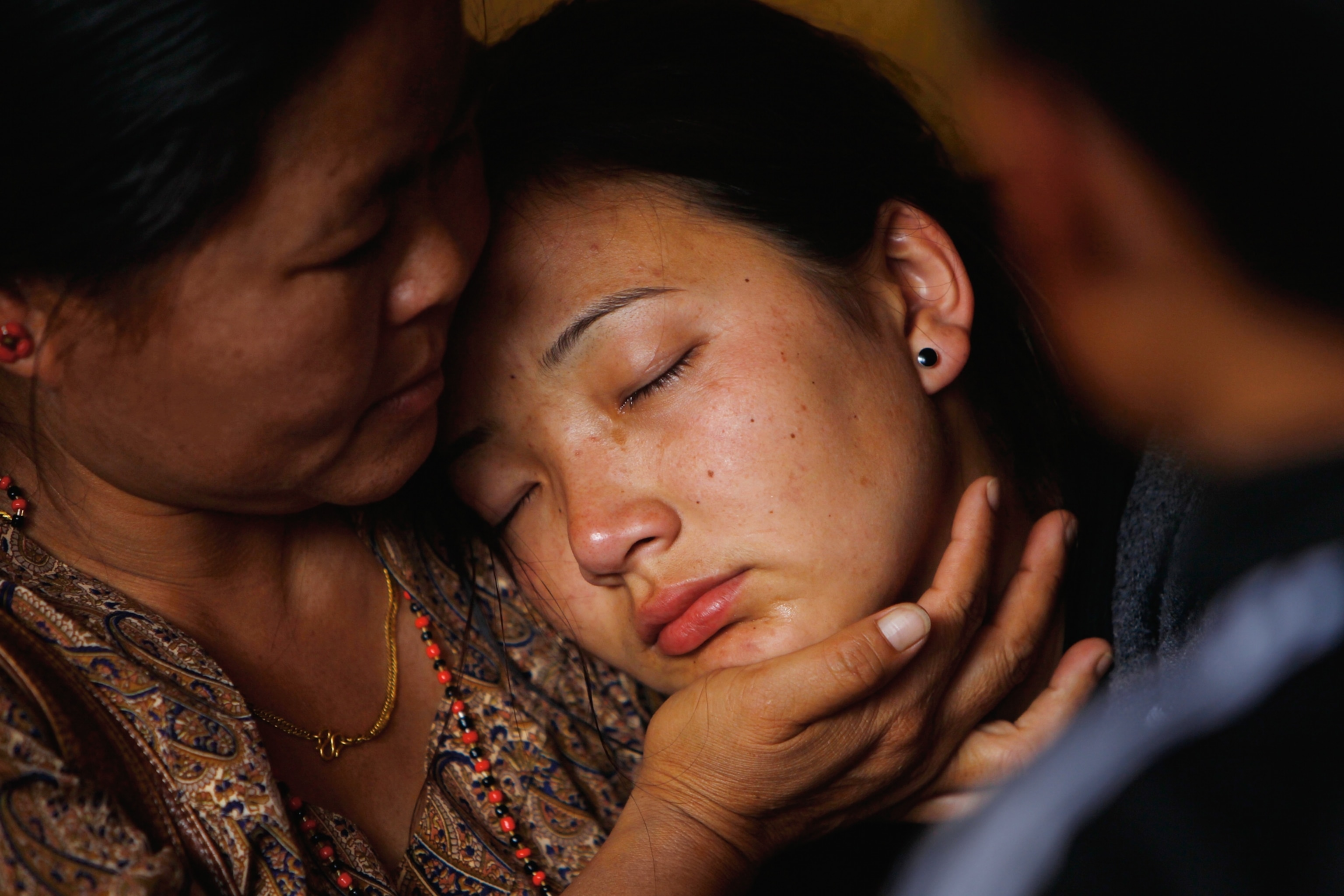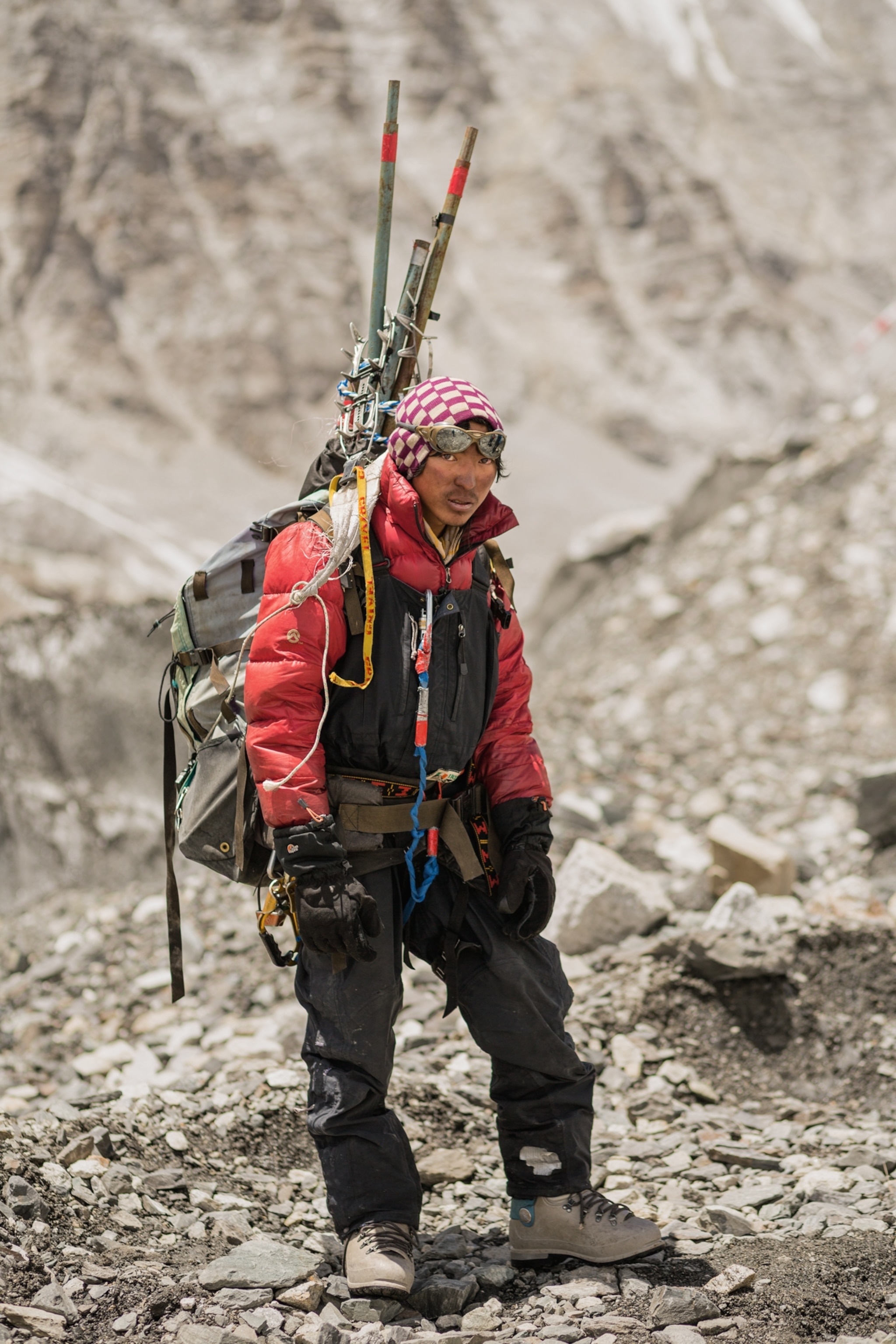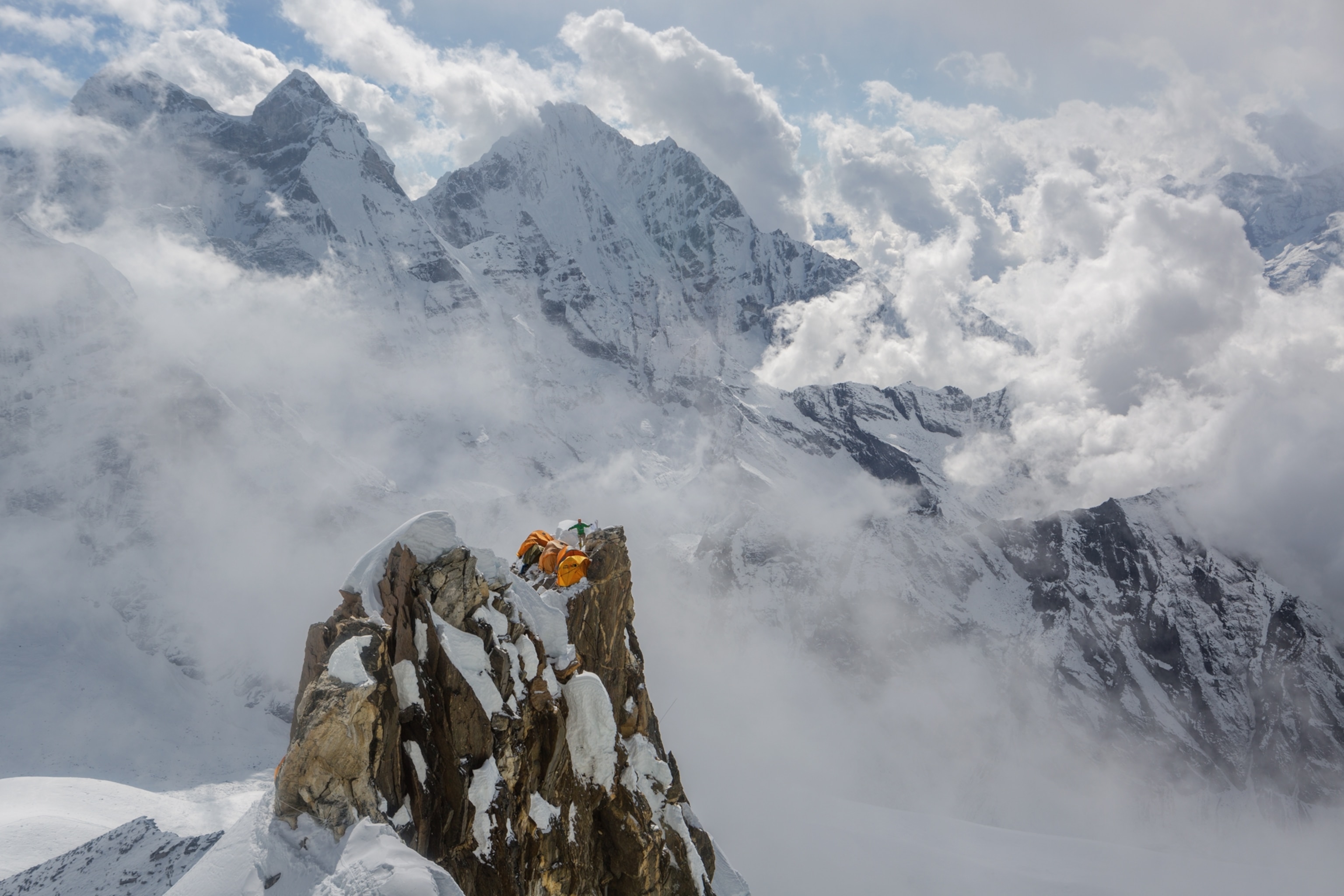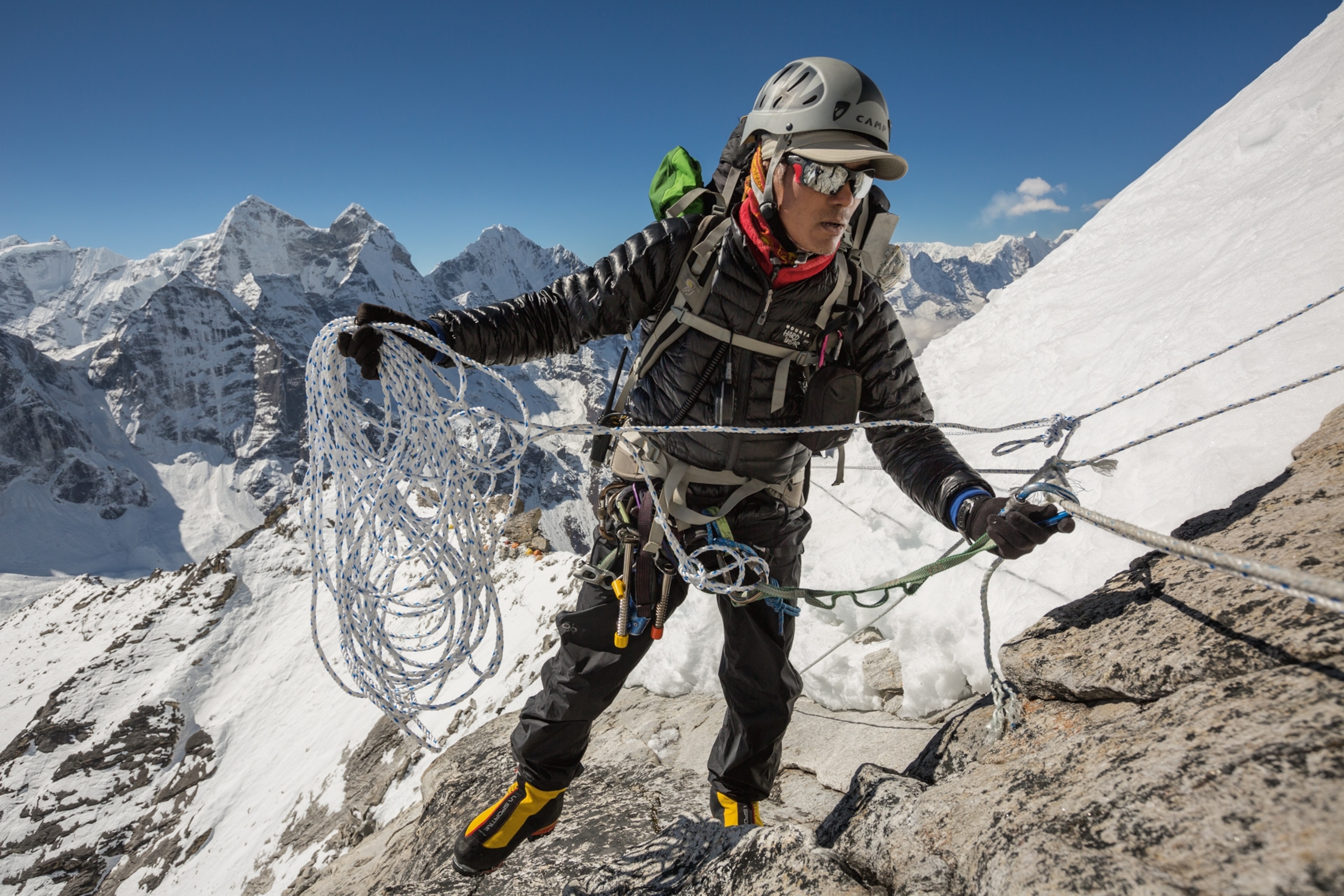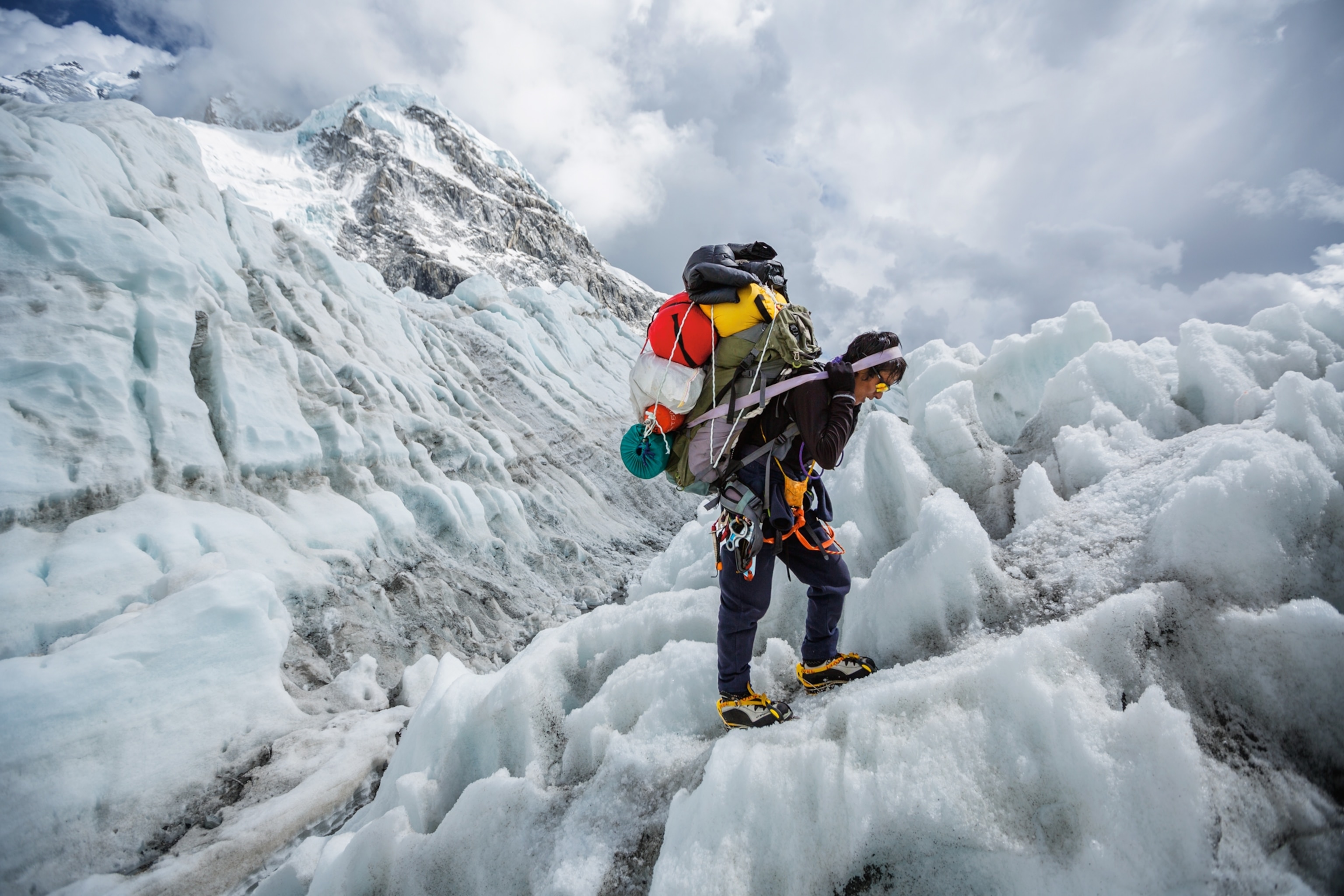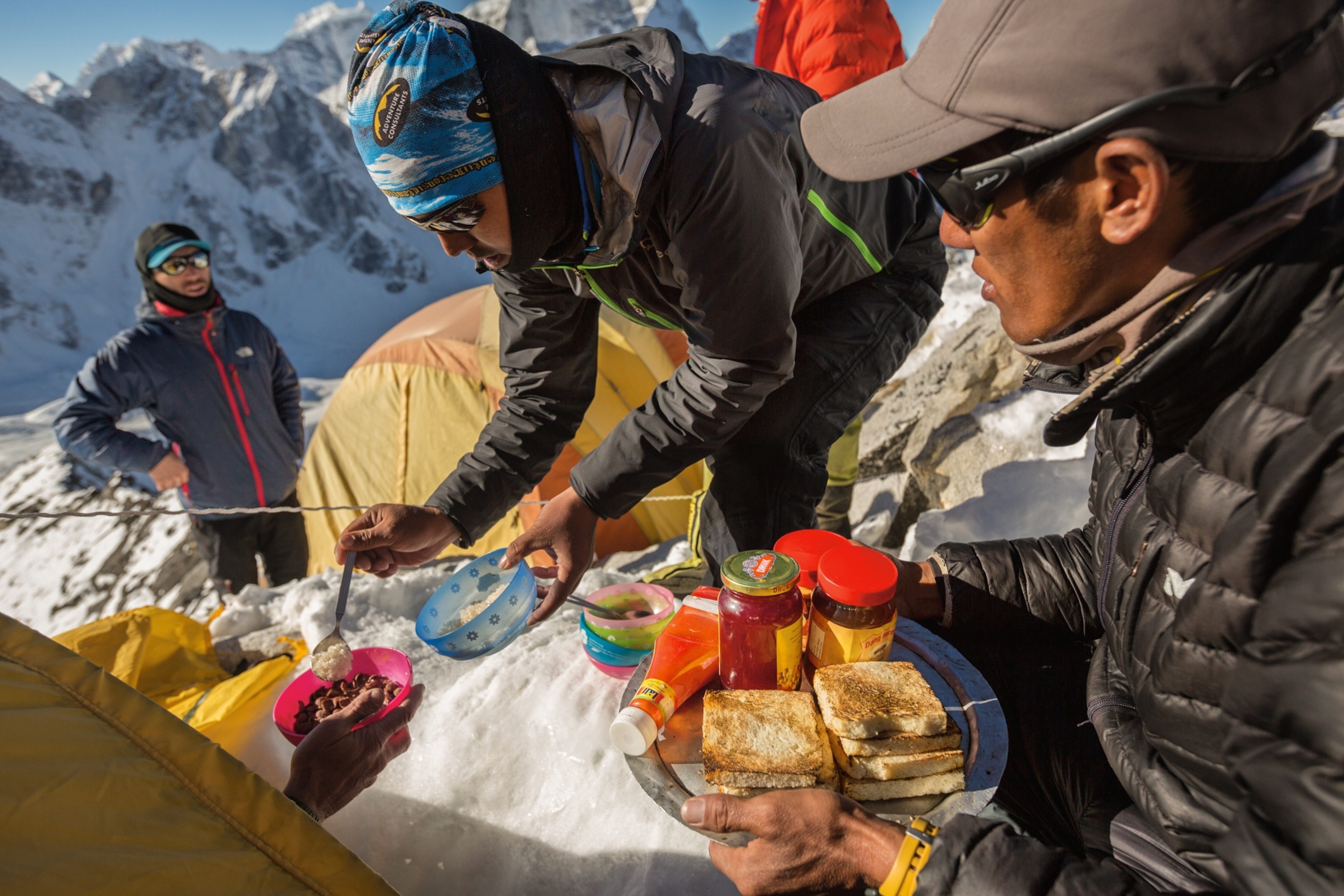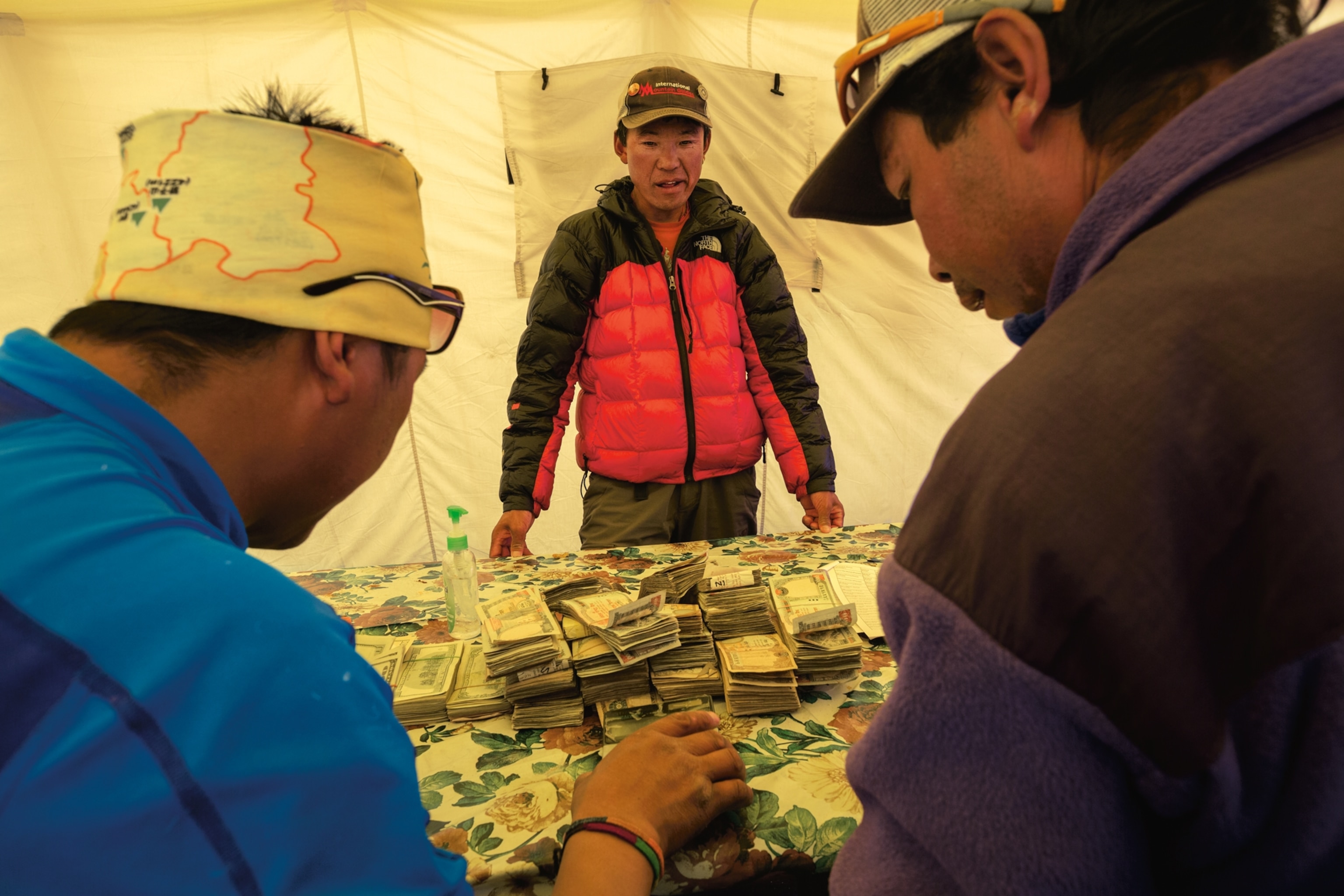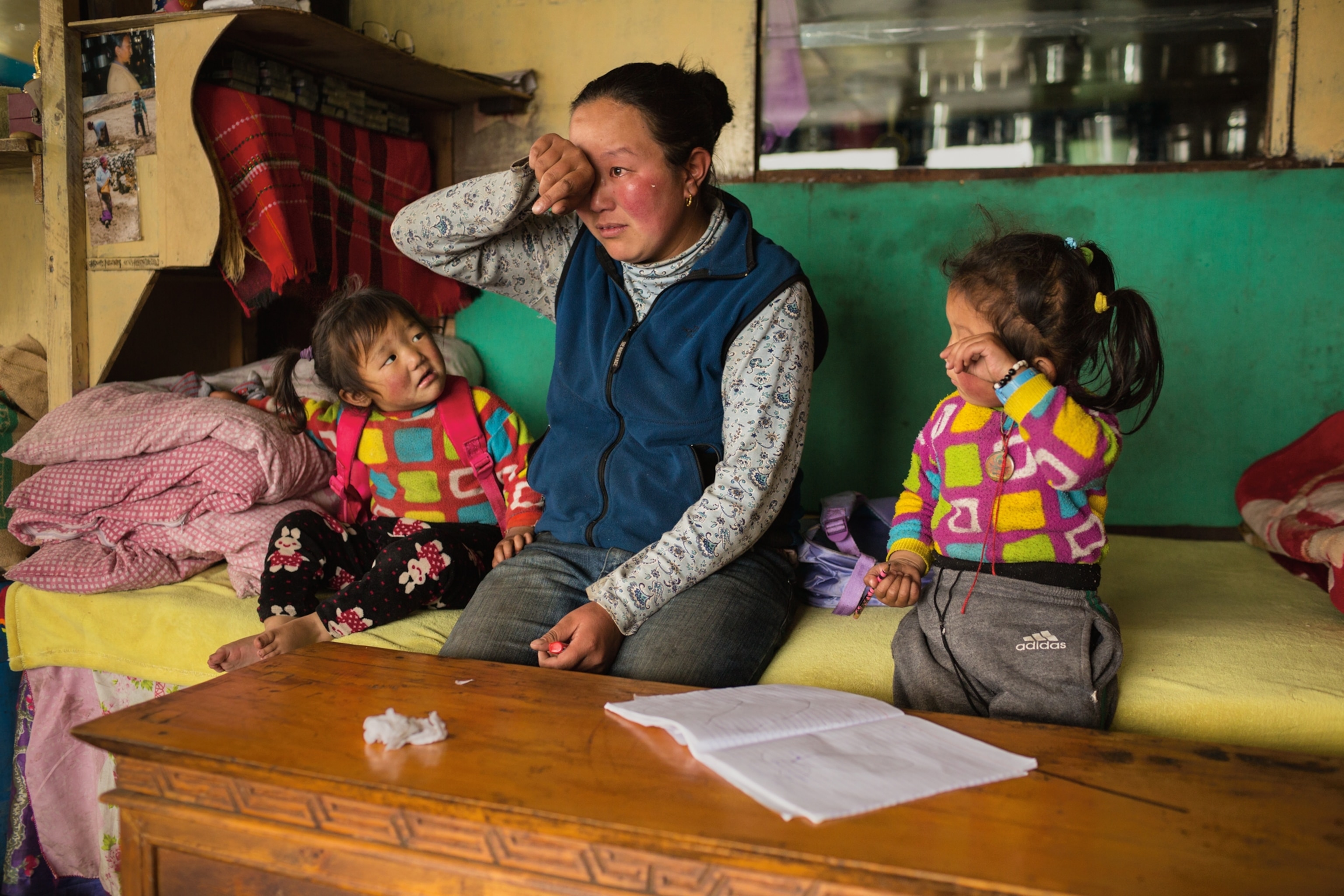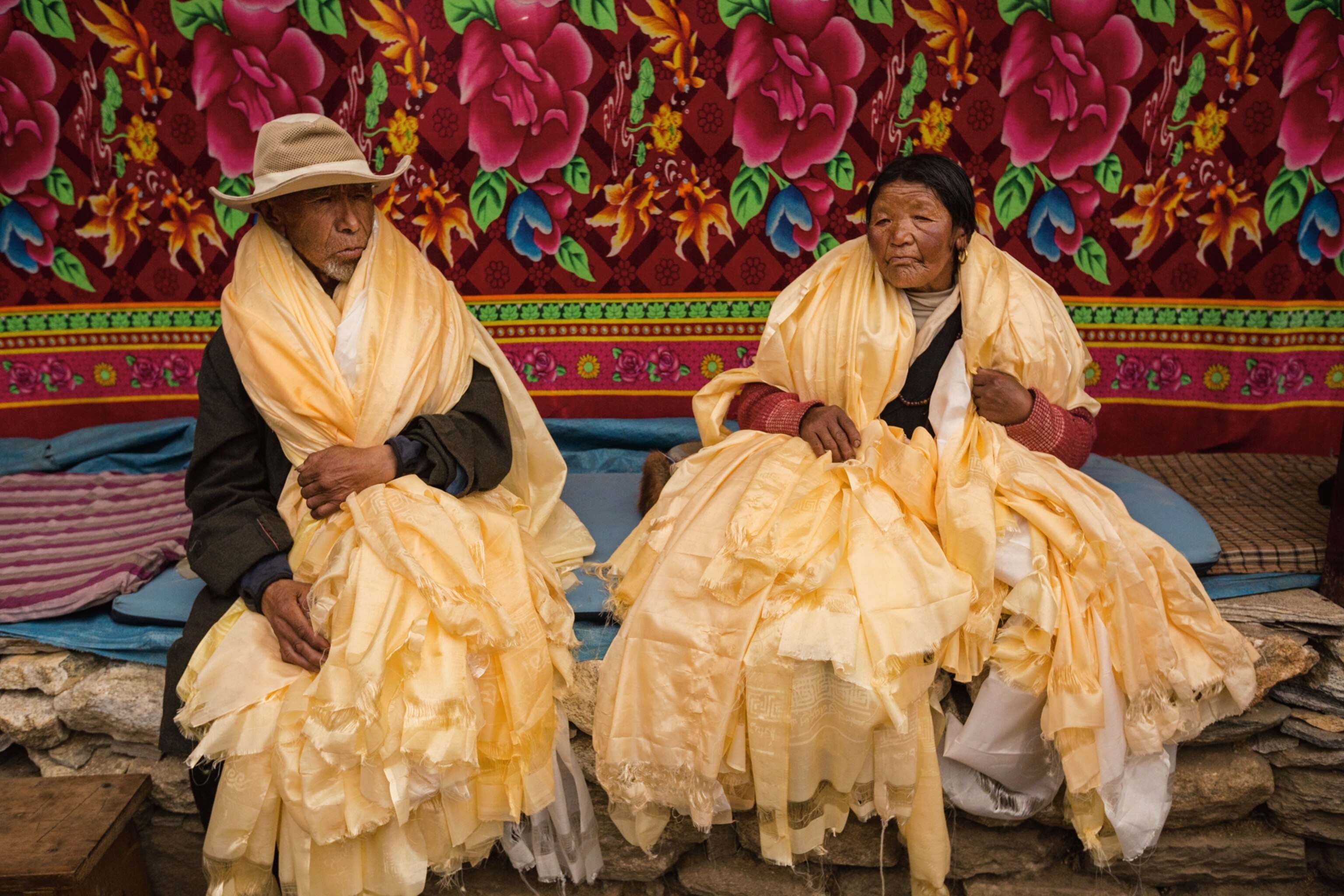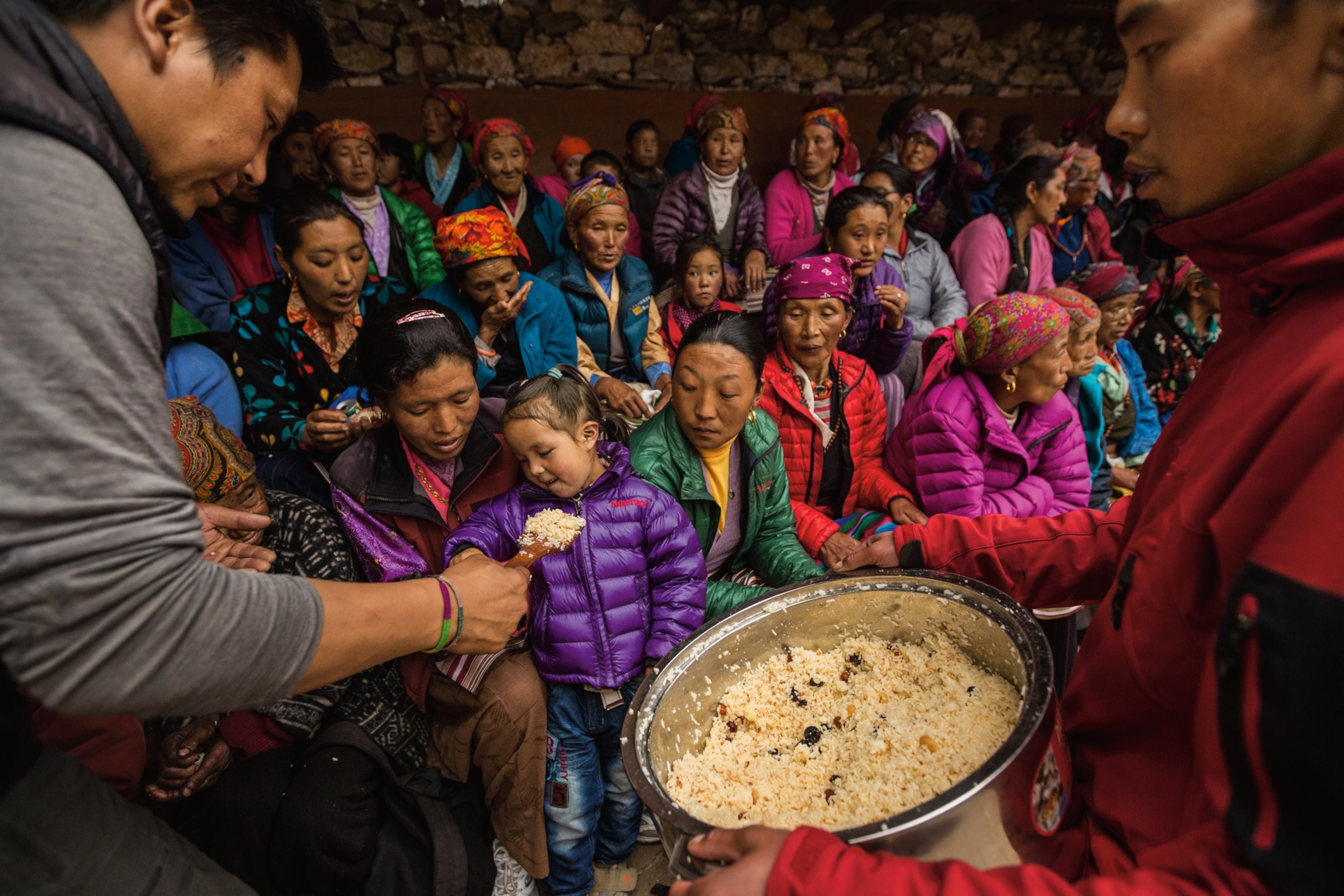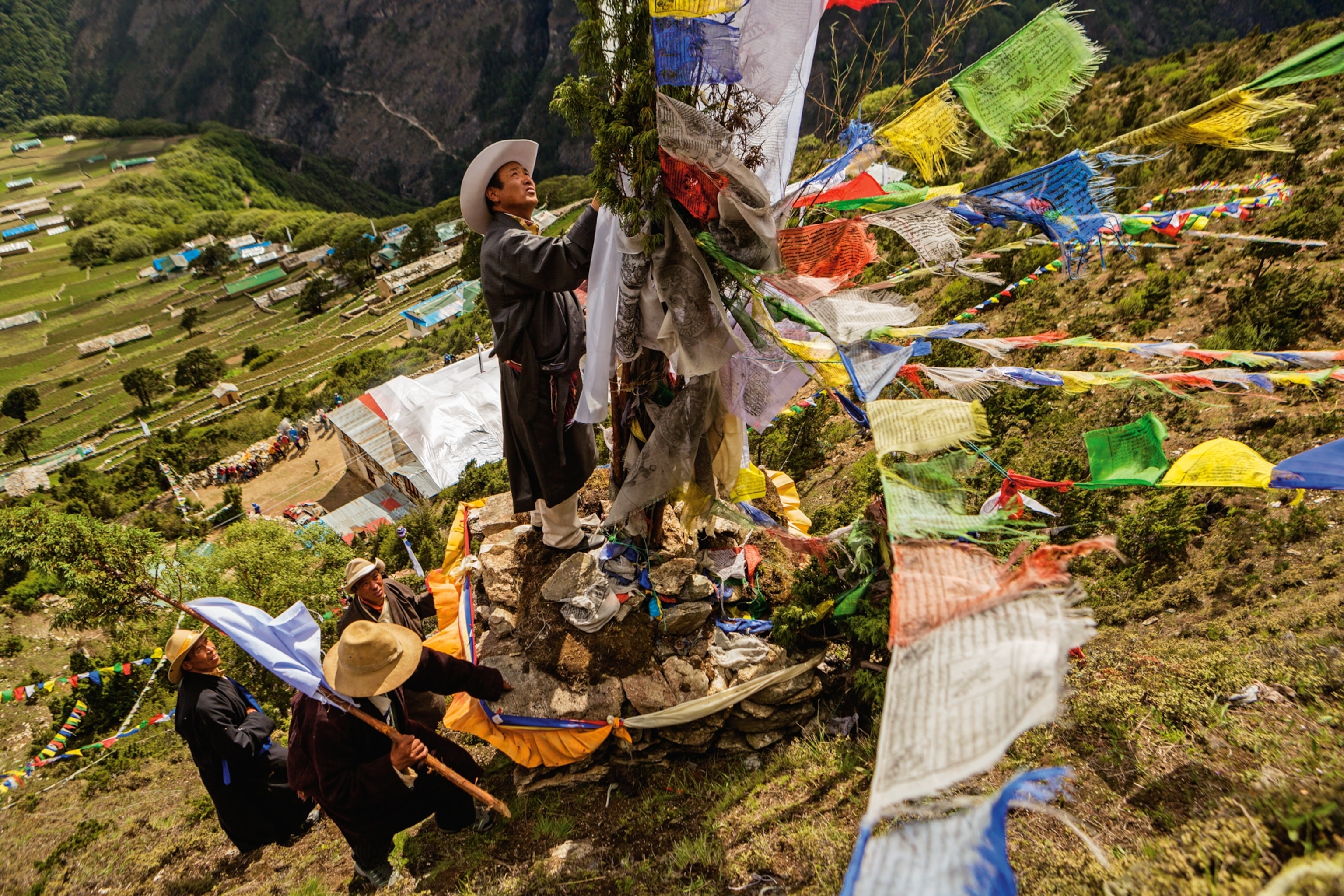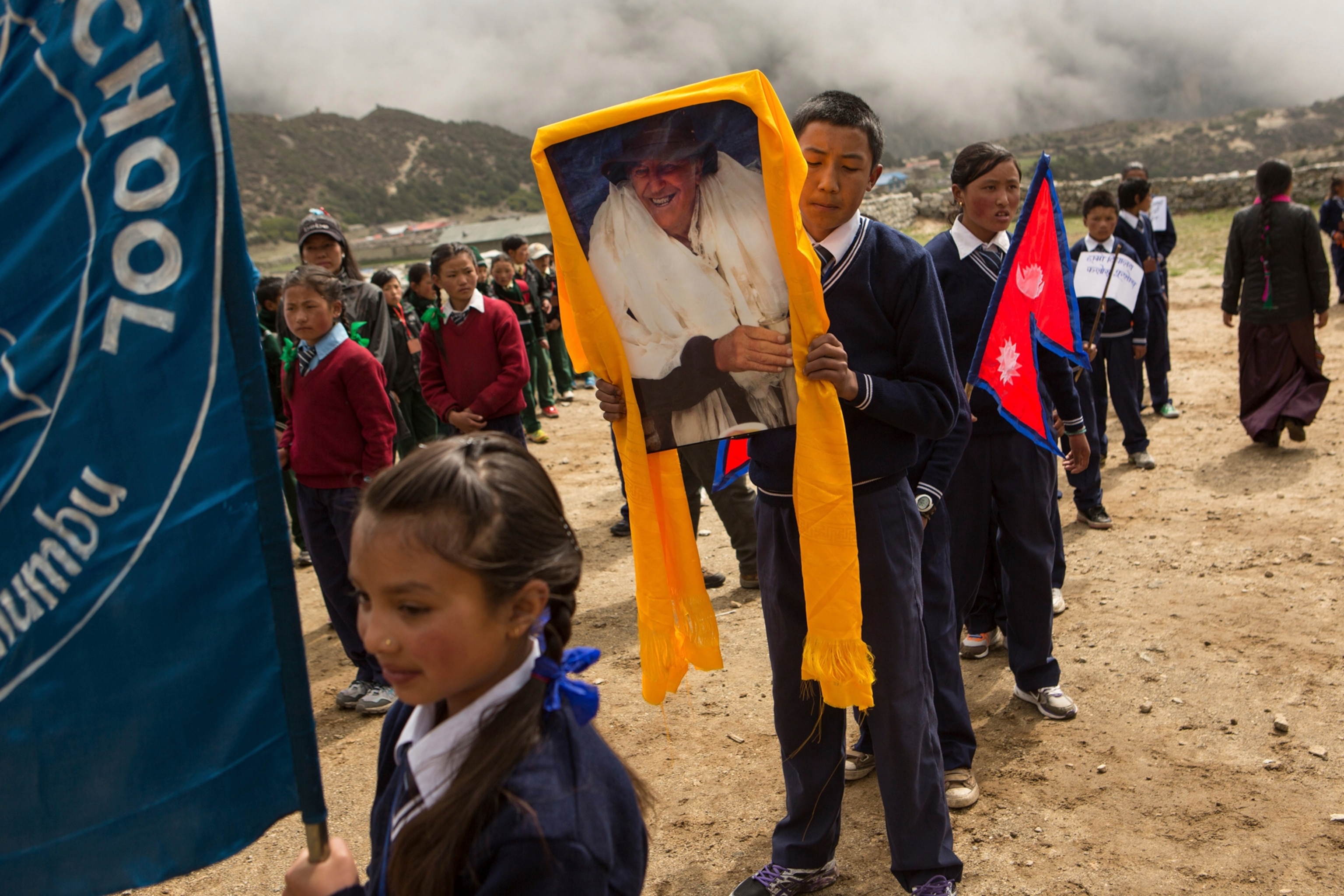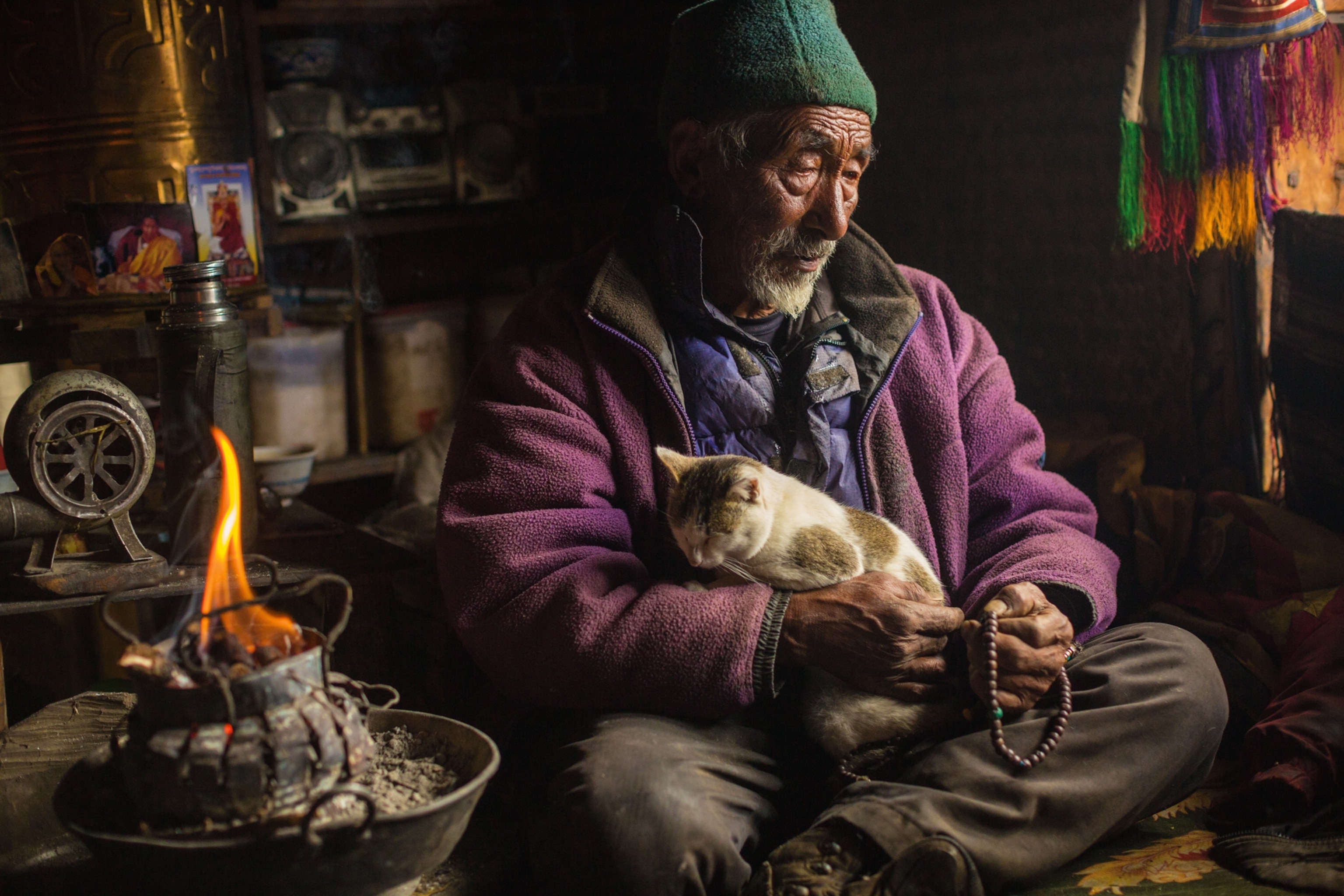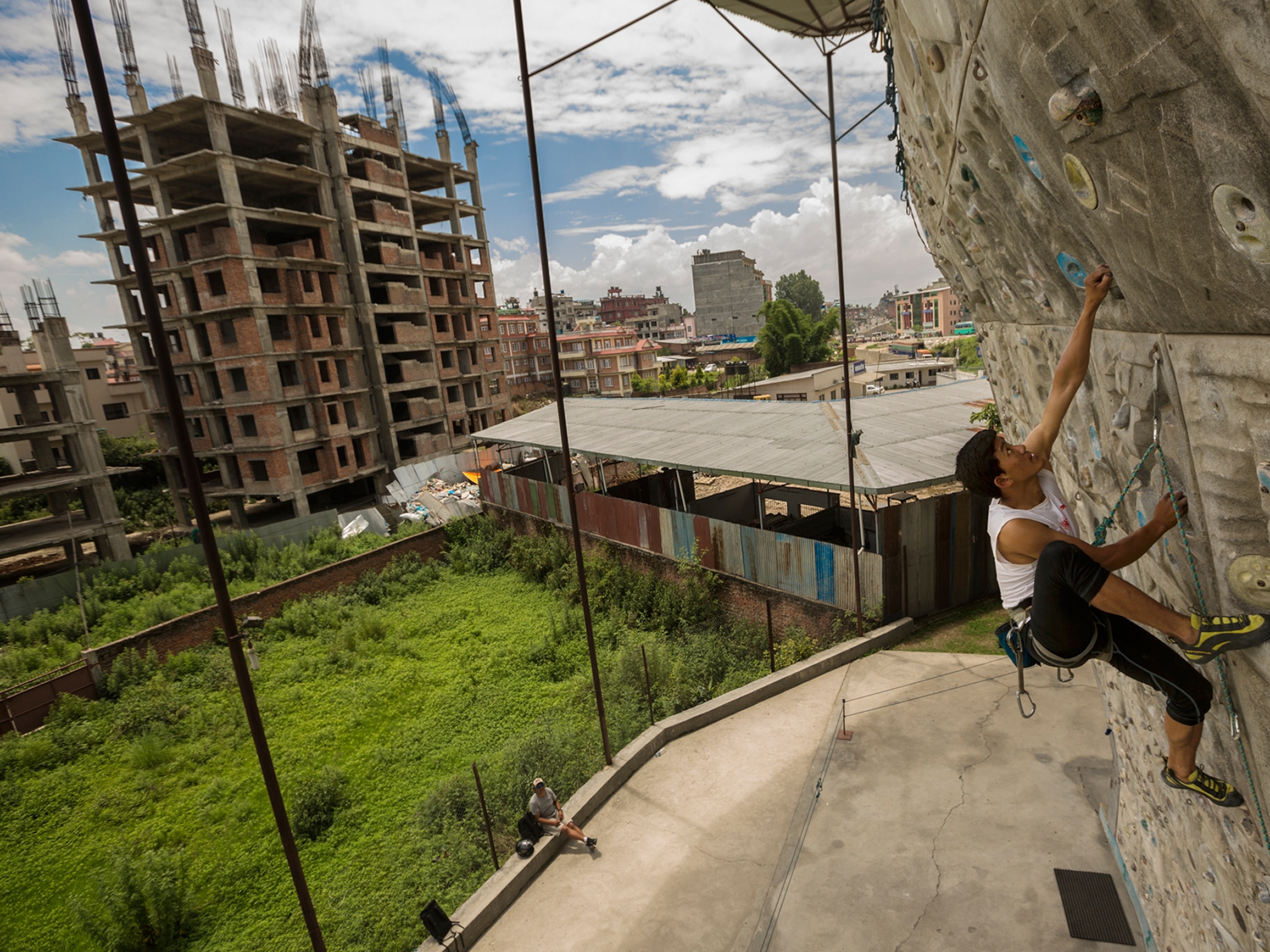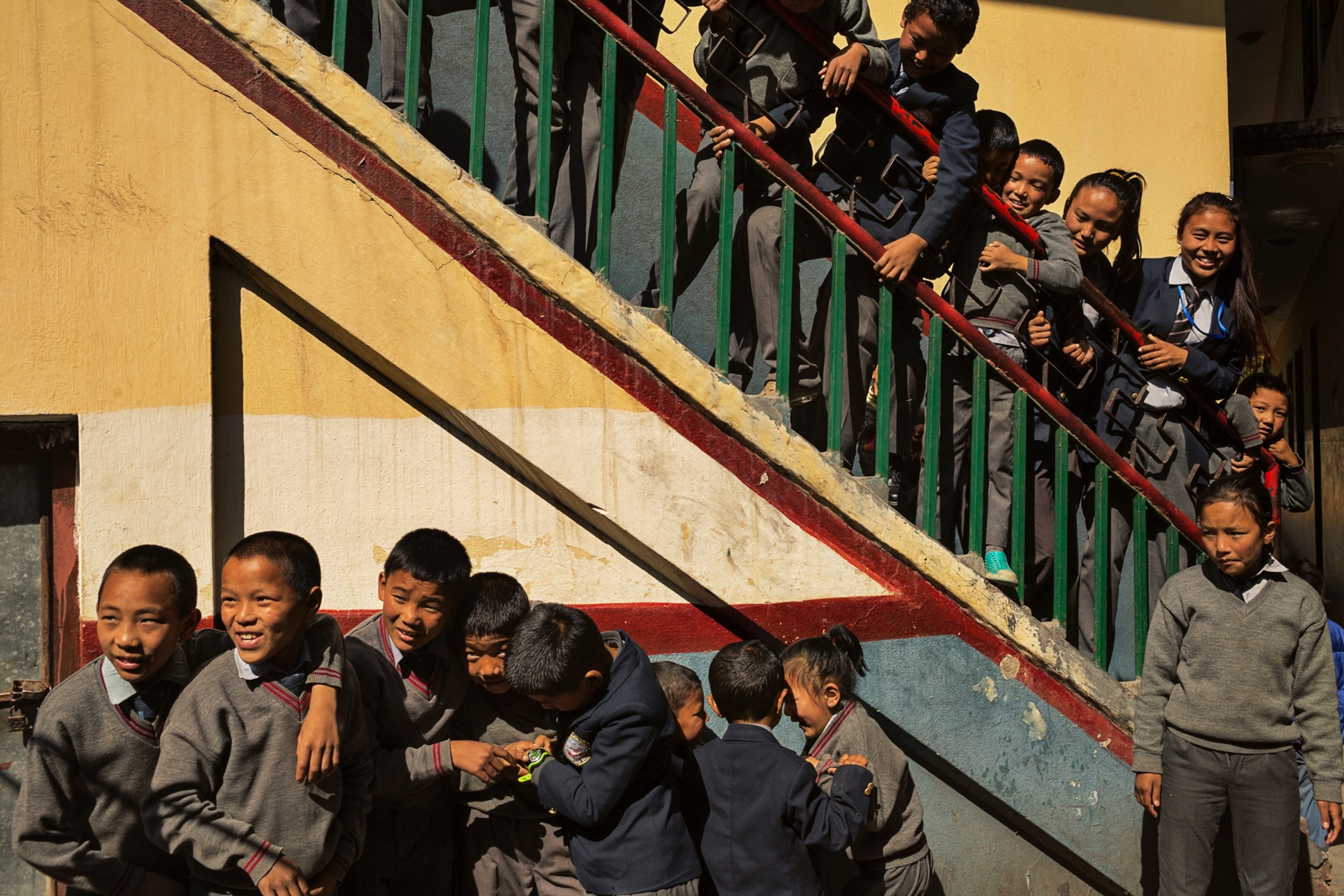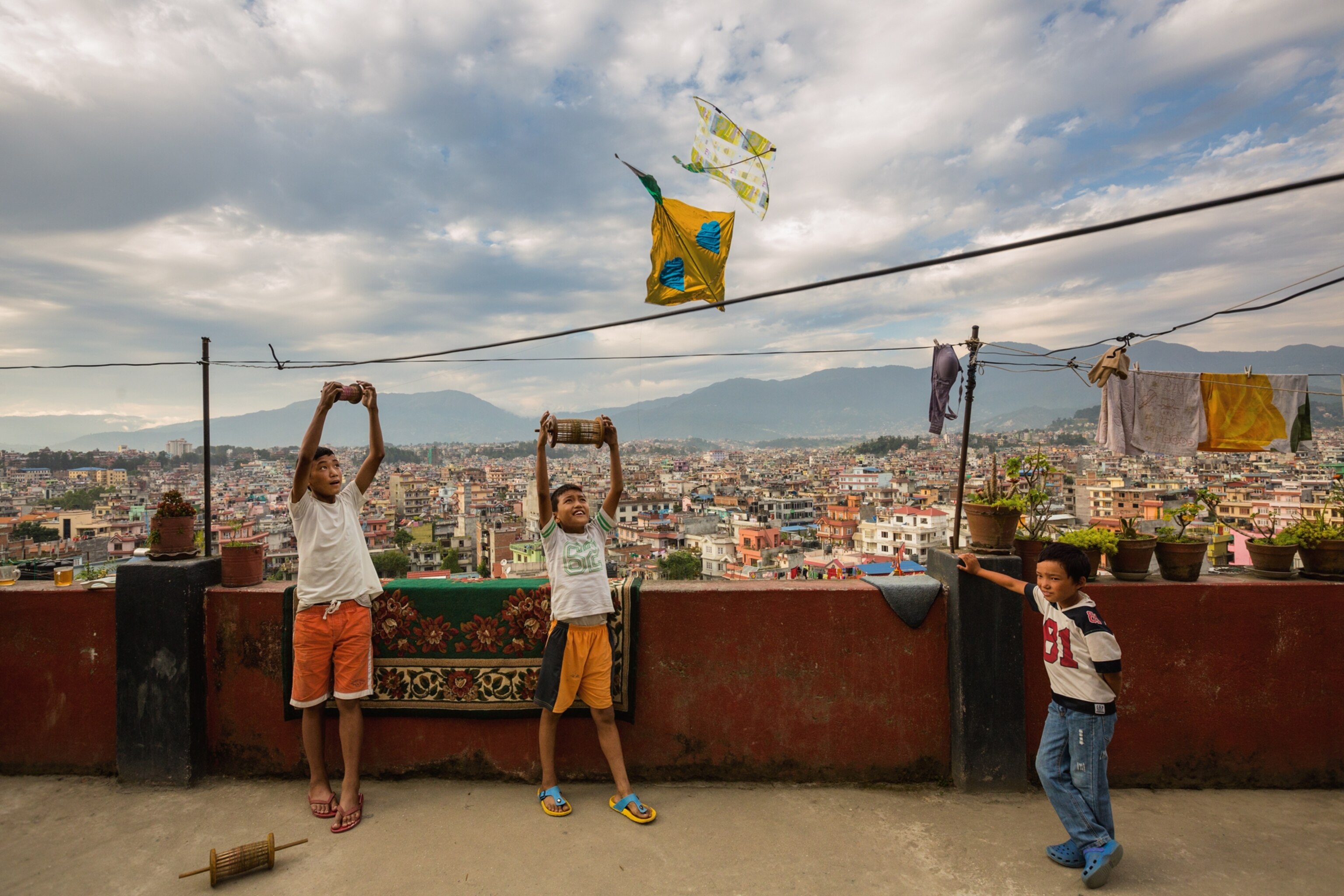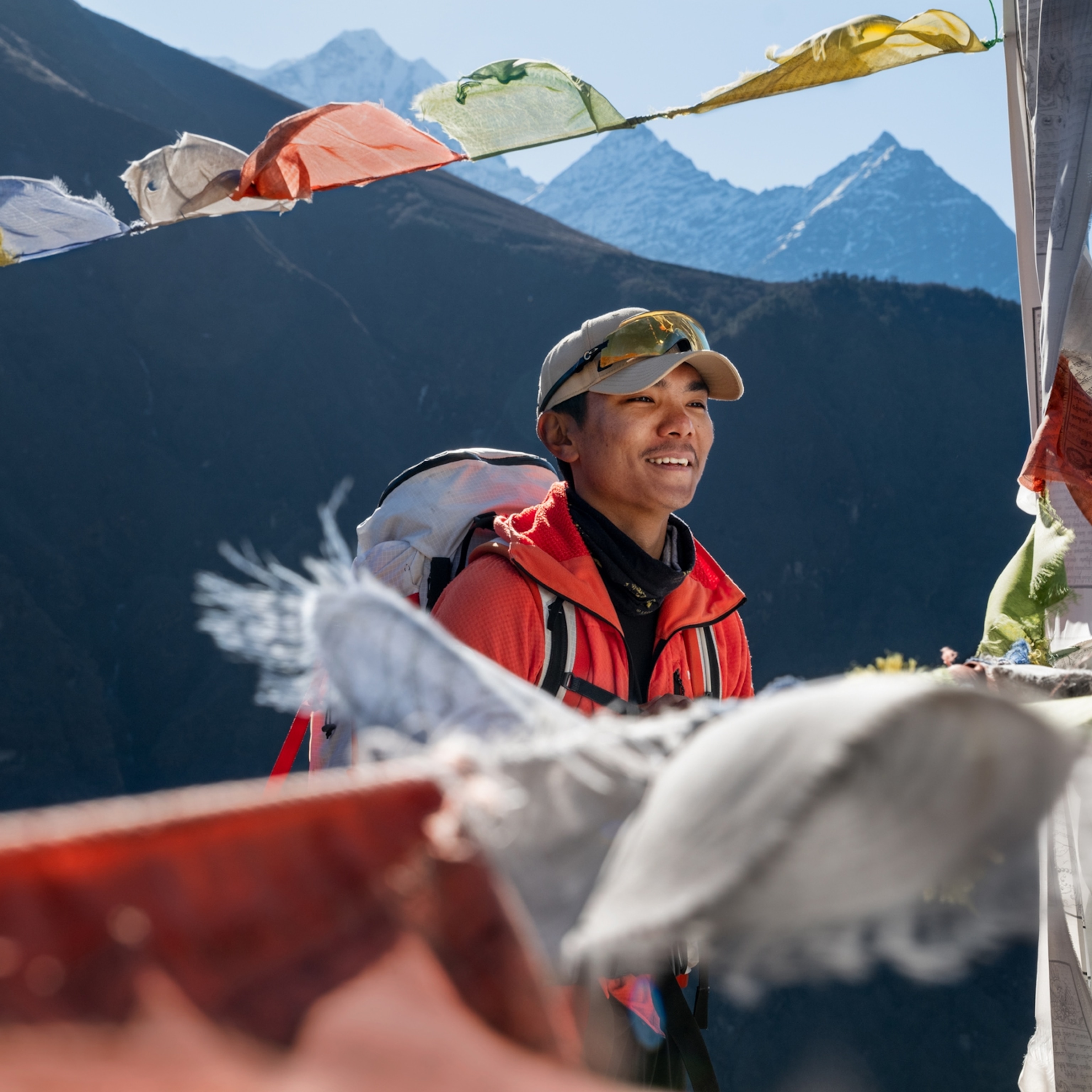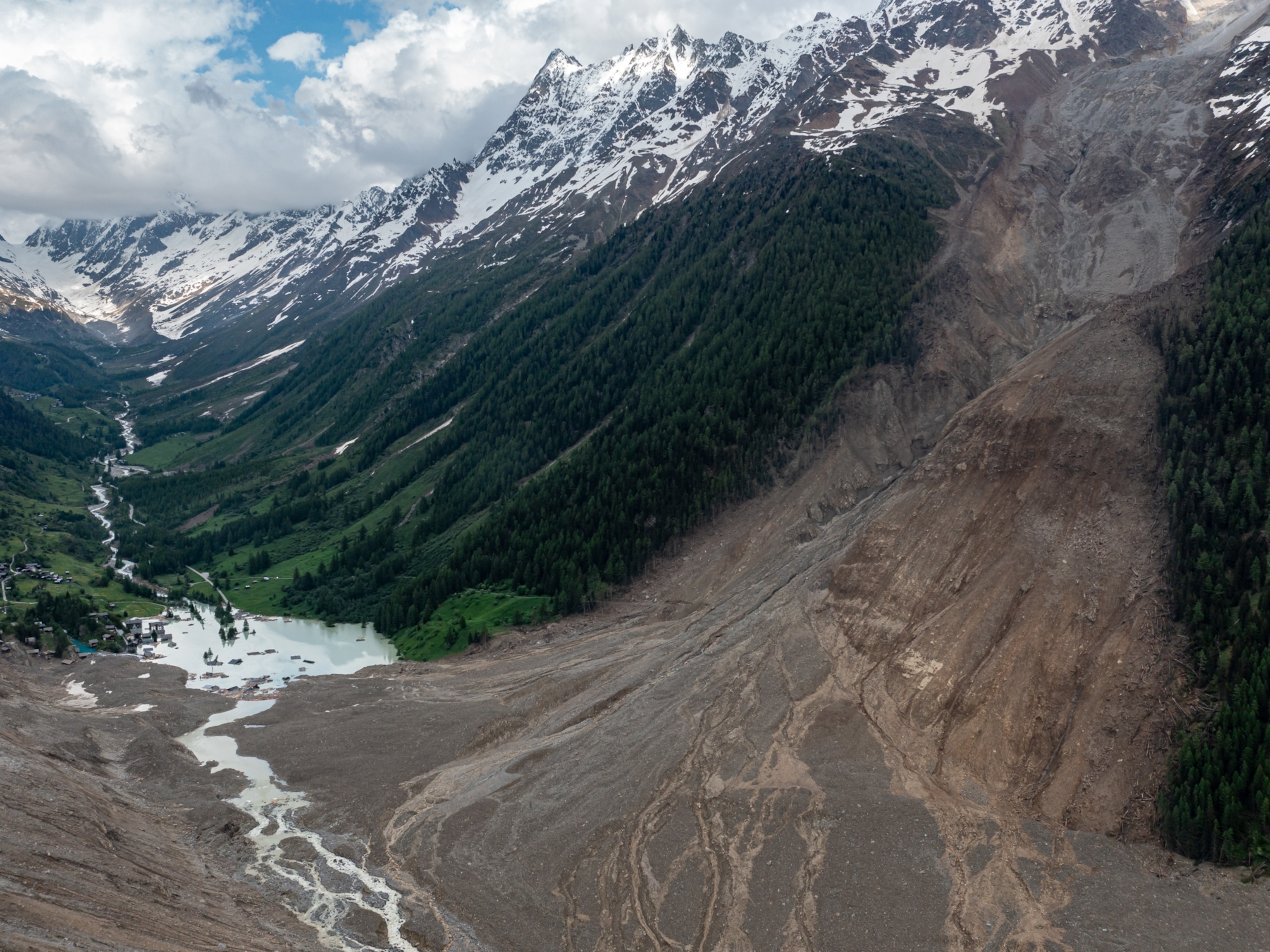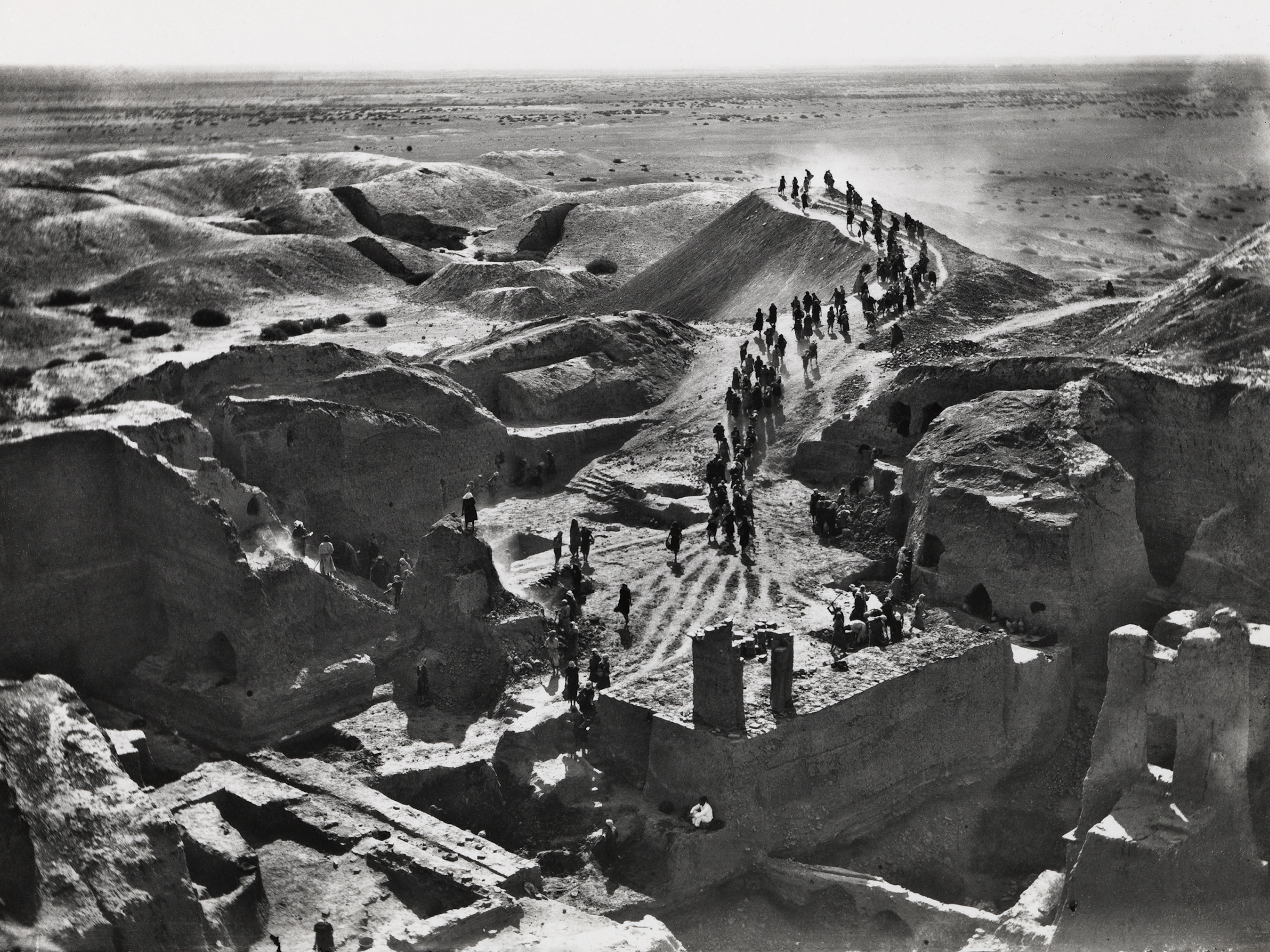Sorrow on the Mountain
How the shocking avalanche that killed 16 expedition workers unfolded on Mount Everest—changing life on the mountain forever
On what would be the darkest day in the history of the world’s highest mountain, Nima Chhiring, a 29-year-old Sherpa from the village of Khumjung with sunburned cheeks and a thatch of black hair, marched to work at 3 a.m. He had a 65-pound canister of cooking gas on his back. Behind him was the temporary village of Everest Base Camp, where the members of some 40 international expeditions were asleep in their tents or tossing restlessly in the thin air of 17,290 feet. Above him a string of headlamps flickered in the darkness, as more than 200 Sherpas and other Nepali workers filed through the Khumbu Icefall. Considered among the most hazardous sections of any regularly climbed mountain anywhere, the icefall is a steep, constantly shifting labyrinth of teetering seracs, crevasses, and contorted ice that spills 2,000 feet down a gorge between Mount Everest’s west shoulder and Nuptse, the 25,791-foot peak that looms over Base Camp.
Many of Nima Chhiring’s fellow Sherpas had trudged into the icefall even earlier on that morning, April 18. They’d had their typical breakfast of tea and a barley-flour porridge named tsamba, and shouldered loads packed the night before. Some were hauling ropes, snow shovels, ice anchors, and other gear they would use to set a handrail of fixed lines all the way to Everest’s summit at 29,035 feet. Others were lugging the equipment with which they would establish four intermediate camps higher on the mountain—sleeping bags, dining tents, tables, chairs, cooking pots, and even heaters, rugs, and plastic flowers to pretty up mealtime for their clients.
On some Sherpas were traces of the roasted barley flour they had rubbed on each other’s faces during the puja ceremonies the previous day, when they petitioned Jomo Miyo Lang Sangma, the goddess who dwells on Everest, for safe passage and “long life.” A number of the climbers already had made several round-trips since the route had been opened in early April by the Sherpa specialists known as the Icefall Doctors. The line of fixed ropes and aluminum ladders spanning cliffs and seams in the ice was not markedly different from the route of recent climbing seasons, though it was closer to the avalanche-raked flank of the west shoulder, where a hanging glacier bulged ominously a thousand feet above.
Even with loads of up to a hundred pounds, most of the Sherpas were fit enough to make the 2.1-mile climb to Camp I in three and a half hours or less. An hour above Base Camp, Nima Chhiring, who was working for a Chinese expedition, reached the area known as the Popcorn, where the route steepened through a hash of broken ice, and ladders were numerous. Further on, at a flat area known as the Football Field, climbers often paused for a rest, and it was common to hear ice groaning as the Khumbu Glacier shuddered forward at the rate of a few feet a day. Above the Football Field was another especially dangerous zone of mansion-size ice blocks and precarious towers, past which Nima Chhiring’s trip would get easier as the Khumbu Glacier leveled out in the massive white plain known as the Western Cwm.
About 6 a.m., above the Football Field, Nima Chhiring reached the base of an ice cliff about 40 feet high. There he began the awkward task of climbing three lashed-together aluminum ladders with the heavy pack on his back, metal crampons on his boots, and an ascender in his hand that he had to clip and unclip as he moved past the anchors of the fixed rope. When he reached the top, he was dismayed to see scores of mountain workers backed up on a sloping ledge of ice about the size of a teahouse dining room. Some were standing around smoking. Some were queued up and waiting to climb down a trench on two lashed-together ladders. At least once that morning, shifting ice had caused the anchors on the low end of the down-climb ladders to come loose and had backed up traffic on the route. Those who had arrived at this section at 5 a.m. had noted long delays, even though the ladder had been reanchored. When Nima Chhiring got there an hour later, he found the anchors had come loose again.
“I think there were more than a hundred people stopped there; many were down-climbing, holding on to the rope. It would take half an hour to get past the backup. At that moment I became very scared,” he said.
“My ear is crying”
In Nepal premonitions of danger are sometimes experienced as a buzzing, high-pitched sound, a phenomenon called kan runu, or crying ear. Nima Chhiring, who had been to the summit of Everest three times, had heard his ear cry before and knew better than to ignore it. He was racked with indecision: Continue dutifully on to Camp I with his load, or deposit the gas canister as far as he’d carried it and go down immediately? He tried to radio his sirdar at Base Camp, but the boss had gone to Namche Bazar for supplies, and Nima Chhiring could raise only the camp cook. Nima Chhiring told the cook that his ear was crying and that he was going to leave his load clipped to the fixed ropes and descend. Other Sherpas asked him what he was doing.
“I said, ‘My ear is crying, and we will hear something bad has happened. I am going down; you should go down too,’” he recalled. He estimated the time was about 6:15.
Word of Nima Chhiring’s crying ear spread. Five Sherpas above the triple ladder dumped their loads and started down. Two working for the Canadian outfitter Peak Freaks had been delayed below the triple ladder and retreated because their feet were freezing. Others didn’t feel they could alter their itinerary on the edict of a crying ear or a cold foot. Between the jam-up and the Football Field, Nima Chhiring passed Sherpas he didn’t know and Sherpas he did. Among the latter: Phurba Ongyal, 25, from Pangboche, who had told his sister this season on Everest would be his last; Lhakpa Tenjing Sherpa, 24, who had a wife and two-month-old daughter in Khumjung; and Ang Tshiri, at 56, one of the oldest Sherpas on the mountain, who was heading up the icefall for what he said was the last time. After 13 years as a cook at Camp II, he planned to retire to his restaurant in Thamo, also called Camp II. Nima Chhiring also passed Ang Tshiri’s half brother Dorje Sherpa, 39, who lived in a dirt-poor house with his family way up the Bhote Kosi river valley in Tarngga, a two- or three-day walk from Everest.
“I told many of them my ear was crying, and they should turn around,” Nima Chhiring said. “They said, ‘We have pressure to get up there. We have to go on.’”
“Nima Chhiring told me not to go up,” said Mingma Gyaljen Sherpa, a 33-year-old from Namche Bazar better known as Babu, who was headed up to Camp I with oxygen bottles and other equipment. “I had to climb on. I had clients’ gear. I had no trouble on the down-climb ladder. It was not broken at 6:34 a.m. when I went past. But there were inexperienced Sherpas waiting to climb down who were very slow.”
Base Camp and the icefall were still in shadow, but far above, the summit haunts of the Sherpa gods were ablaze in light. Top to bottom it would be a beautiful morning on Everest—for 11 more minutes.
“I had no chance to run”
So vast is the amphitheater of mountains around Everest Base Camp that climbers often see avalanches before they hear them. The sound follows like thunder after lightning, an oceanic hiss as cataracts of snow and ice and rock pour down steep gullies or over the lip of hanging valleys. But the avalanche of April 18 sounded different, especially to Sherpas who heard it while in the icefall itself. Almost all of them described it the same way: a deep tuuung, like the blow of a hammer against a muffled bell or a plucked string from some titanic bass.
A section of ice shaped like an enormous canine tooth, 113 feet tall and weighing 16 to 30 million pounds, exploded off the great ice mantle on the west shoulder of Everest and came hurtling down, fracturing into pieces and driving before it a wall of wind. As it gathered momentum and material, some Sherpas thought the avalanche took minutes to reach them; others said it struck in a matter of seconds. About two dozen climbers were directly in the path of the avalanche, and many others were at the margins above and below.
At 6:45 a.m. Kurt Hunter, the Everest Base Camp manager of Madison Mountaineering, was on a radio check with Dorje Khatri, the company’s 46-year-old sirdar and a well-known union man who had unfurled different trade union banners each of the nine times he’d reached Everest’s summit. Khatri had just gotten to the top of the triple ladders. Suddenly over the radio Hunter heard “shouting and yelling” and then “absolute silence.” As the roar of the avalanche reached Base Camp directly, he dashed out of the communications tent to see the upper icefall consumed in a boiling cloud.
Hustling down for ten minutes, Nima Chhiring had reached the Football Field when the sound of the tuuung confirmed his worst fears. In seconds he was plastered in freezing rime, one of many survivors who staggered to their feet cloaked like ghosts in snow and ice. Pemba Sherpa, a young Everest veteran from the village of Phortse who had departed Base Camp at 4 a.m. on an acclimatization hike with a client from Alaska, had just reached the Football Field. Hit by a rush of wind, he looked up to see “a block of ice as large as a big house” bowling off the west shoulder. He bolted downhill with his client, and they threw themselves behind an ice formation as the sky was blotted out.
Karna Tamang, a 29-year-old guide with five Everest summits, had left Base Camp at 3 a.m. He was less than five minutes above the broken ladder when he heard thetuuung.
“I had no chance to run,” he recalled. “There was a shocking wind. To protect myself, I got down on my knees by a large block of ice and tried to save my face. I was covered by two inches of snow.”
Babu Sherpa was about a minute above the broken ladder in a group of six Sherpas. “We huddled together. When the snow cleared, I looked down, and there was nobody below me,” he said.
Fifteen minutes before the avalanche, Chhewang Sherpa, a 19-year-old working for New Zealand-based Adventure Consultants, had scraped through the section where the broken ladder had been. He was on his first Everest expedition and traveling with his brother-in-law, Kaji Sherpa, a 39-year-old father of three. Kaji clambered up a small ice cliff, secured to the fixed rope by his safety line. When the avalanche hit, Chhewang unclipped from the fixed rope and ran, and then crouched under his pack. As he later told his uncle Chhongba Sherpa, the Nepal-based director of the Khumbu Climbing Center, ice severed Kaji’s safety line and knocked his brother-in-law unconscious. Chhewang was able to catch him and drag him to a safer spot. He poured a hot drink from Kaji’s thermos, hoping to revive him.
“Kaji slowly woke up. He had a radio, I pressed the speak button because both of Kaji’s arms were not working at all. He said, ‘Please save me!’ If I hadn’t caught him, he would never have been seen again, because the crevasse was so deep.”
Pasang Dorje Sherpa, a 20-year-old working for Seattle-based Alpine Ascents International, was climbing with two other AAI Sherpas, Ang Gyalzen and Tenzing Chottar. It was Pasang’s second season on Everest. He was carrying a large dining tent pole, a thermos, and a coil of tent rope. When he heard the tuuung, he and Ang Gyalzen were about 45 seconds beyond the broken ladder—Tenzing Chottar only steps behind them. Tenzing, 29, was another Everest rookie. He had completed the basic and advanced mountaineering course at the Khumbu Climbing Center and was glad to have the job; he supported his elderly parents and had a three-month-old son. At Base Camp the day before, he had been able to call his wife, Pasi Sherpa, in Kathmandu.
“I saw the ice coming, and I thought, We are gone, I am going to die,” Pasang Dorje recalled. “The wind was pushing me. I dived behind a big serac. If I hadn’t been clipped into the fixed rope, I would have been swept away.”
The ice slammed the tent pole against his head. It shattered his thermos and cut the rope. Flying ice punched a hole in Ang Gyalzen’s down jacket. When the devouring cloud cleared two minutes later, the two Sherpas hugged each other, then looked around in horror. What had been a yawning chasm in the icefall requiring ropes and ladders to cross was now filled in with ice blocks as big as tables and couches. “Tenzing! Tenzing!” they shouted in vain.
Alerted by Michael Horst, a guide at Base Camp who saw the avalanche, Lakpa Rita, the sirdar for AAI, scrambled into his boots. He put a long antenna on his radio and tried to make contact with any of his staff traveling through the icefall that morning—33 climbing Sherpas, one cook, and two kitchen assistants. He finally reached Pasang Dorje, who told him maybe five or six Sherpas behind him were covered, and probably dead.
“I was very, very nervous,” Pasang Dorje said. “I saw a Sherpa vomiting blood and a half-buried guy with his eyes all white, asking for water. We pulled him out. I don’t even know his name. Most of my friends were crying.”
“I tried to hide my tears”
Sherpas and Western guides who had reached Camp I earlier headed down to help shortly after 7 a.m. At Base Camp, Lakpa Rita set off on the two-hour climb to the impact area with his brother Kami Rita, as did Horst, Ben Jones, Damian Benegas, and other guides. At Base Camp teams brought sleeping bags, shovels, and rescue equipment to the middle of the camp’s three helicopter pads. Joe Kluberton, the AAI Base Camp manager, along with Caroline Blaikie and Mike Roberts of Adventure Consultants, began coordinating radio traffic. The airwaves were full of chatter as Sherpas confirmed their status. The number of dead was still unclear.
“We started to meet a lot of wounded Sherpas coming down,” Lakpa Rita recalled. “They had bruises and blood on their heads. Some were limping from where they’d been hit by blocks of ice. I offered to help them, but they said, ‘The guys up higher need more help than us.’ I knew chances were nil anyone who had been buried would still be alive—they might have had 15 minutes at most.”
It took Lakpa Rita almost an hour to get from the Football Field to the impact zone. Blood on the snow marked the area. He found about 50 Sherpas at the site, some digging with steel spades, some hacking at the debris with ice hammers, some sitting numbly in shock and grief. Four bodies had been placed under a gray tent fly. At the sight of the shrouded forms, Lakpa Rita sat and wept.
“I tried to hide my tears from my Sherpa team, but I couldn’t keep them in,” he said.
When he could look under the tent fly, he found that none of the dead were wearing the jackets AAI had issued its staff, and he set about helping the diggers. Two more corpses were freed from the ice, then another: Ang Tshiri, the cook. “Ang Tshiri was one of mine,” he said.
At Base Camp, amid a flurry of reports and rumors, tense radio traffic, and panicked phone calls, nine doctors from various expeditions gathered at the Himalayan Rescue Association clinic tent. Five climbers who had been strafed by ice were able to walk out of the icefall and eventually were treated at the clinic for bruises and lacerations. Three others would have to be evacuated by helicopter. At the impact site Damian Benegas started counting casualties and at 9:09 a.m. radioed that there were at least ten dead. Two Simrik Air helicopters piloted by New Zealander Jason Laing and Nepali Siddhartha Gurung arrived at Base Camp. Laing picked up the American mountaineer Melissa Arnot, a paramedic with five Everest summits; she delivered medical supplies to the rescue operation at 10:05. By 10:49 four Sherpas had been helicoptered off the icefall with leg fractures; pelvic, abdominal, and head injuries; and internal bleeding. Among them was Kaji Sherpa, who was transported to a Kathmandu hospital with a punctured lung and two broken ribs. Shortly after 11 a.m. all the wounded had been evacuated to Base Camp, and the rescue teams turned to the task of recovering bodies. Twelve times, from 11 a.m. to 2 p.m., Laing hovered the red, black, and silver Eurocopter AS350 B3e over the phantasmagoria of Everest’s icy gateway and then veered off with a limp form dangling in boots and crampons at the end of a hundred-foot cable. The dead were delivered to the lowest of the Base Camp’s landing pads, where they were numbered with pieces of duct tape and bundled into tarps. Sophie Wallace, expedition doctor for Adventure Consultants, sometimes had to throw herself across the bodies to keep the tarps from blowing off in the rotor’s downdraft.
The identities of the victims were confirmed by teammates or sometimes by family members who also were working on the mountain. Uncertain of Ang Tshiri’s fate, his son Pemba Tenjing had raced down from Camp I only to discover a pair of heartbreakingly familiar shoes. Dawa Nuru Sherpa, from the village of Samde (and a veteran of 13 Everest summits), knew Ang Tshiri was dead when he saw the cook’s hand poking out of the snow. Their grandfathers were brothers, and he recognized the callus where his cousin had habitually brushed his left thumb against strands of yak wool he was twisting into thread.
The rescue workers were concerned that the west shoulder of Everest might unload again, and the grim work was suspended at 2:10 p.m., when afternoon temperatures made the icefall even more unstable. Crews would not be able to extricate Dorje Khatri’s body, still partially encased in ice and hanging upside down in a crevasse above the triple ladder, until the next day. Three climbers were missing and presumed dead. All 16 of the deceased were Sherpas or workers of other Nepali ethnicities. They had died in harness, laboring to put their children through school, or to build a new house, or to buy asthma medication for elderly parents. Twenty-eight children had lost their fathers. Eleven of the dead had been killed in one place—the sloping ice ledge where they were waiting to descend the now obliterated down-climb ladder.
“I believe they tried to escape, and when they realized they couldn’t, they huddled together,” Lakpa Rita said. The horror of the day had surpassed all previous accidents on Everest, including the catastrophes of 1922, 1970, and 1974, when Sherpas had also died in groups. And yet the impact of it was only beginning to unfold.
A tense debate
The days after the avalanche were a chaotic mix of pujas, funerals, meetings, questions, rumors, demands, provocations, and epiphanies. Would the climbing season continue? Should it? How long was long enough to mourn? Russell Brice of Himalayan Experience and Eric Simonson of International Mountain Guides gave their large Sherpa teams leave to go home for four days. Not all of them wanted to come back. One Sherpa outfitter reported that a wife had threatened suicide if her husband returned to the mountain.
Lakpa Rita knew immediately the climbing season was over for AAI—he could not ask Sherpas he had hired to resume when they had lost five teammates and bodies were still buried in the ice. Sherpas on other teams said they would continue but began to feel pressured by activists who saw the tragedy as a chance to press for improvements to the mountain guides’ working conditions. Many Sherpas were infuriated when the Nepali government offered each victim’s family about $415 compensation, money that wouldn’t even begin to cover the cost of a funeral.
Numerous people have noted a new assertiveness among the younger generation of Sherpa guides and workers, particularly after last year’s so-called brawl, in which three well-known European climbers got tangled up with a Sherpa rope-fixing team above Camp II. In the days after the avalanche, labor tensions that had been hinted at a year ago came fully into view when angry, grieving Sherpas effectively unplugged the Nepali government’s multimillion-dollar Everest cash machine, which annually brings the government more than $3 million in permit fees and ancillary economic benefits estimated by foreign expedition operators at more than $15 million. As one Sherpa blogger in Kathmandu said of the tragedy: “The things we couldn’t change showed us the things we could.”
On Sunday, April 20, two days after the avalanche, expedition leaders, rescue workers, and people affected by the accident met in the tent of the Sagarmatha Pollution Control Committee (SPCC), a locally run nonprofit organization that oversees the Icefall Doctors and garbage management on Everest. Among the outspoken Sherpas attending were Nepal Mountaineering Association board member Pasang Bhote and Pasang Tenzing, a 29-year-old with ten Everest summits who was an assistant expedition leader for the British company Jagged Globe. Out of the meeting came a list of 13 demands for government officials. Among other things, Sherpas sought increased insurance coverage and a bigger slice of Everest permit fees to pay for a fund that would support the families of mountain workers killed or injured in the future.
On Monday, April 21, emotional images of the Sherpa funerals in Kathmandu were broadcast around the world, and the next day a giant puja attended by 22 lamas was held at Base Camp. Afterward the bill of demands was read aloud in Nepali and English. Tensions were building. Some people in the crowd shouted that they didn’t want to climb. “It was clear to me that the majority of workers simply wanted to just go home in respect for the dead and for their own safety,” wrote Sumit Joshi, founder of Himalayan Ascent, a Nepali-owned firm. Western expedition bloggers described the meeting as having been “hijacked by militants and turned into a political rally.” Base Camp was roiling with talk of a boycott and threats by “Maoists” and “militants” against anyone who disagreed. Meanwhile, the Ministry of Culture, Tourism and Civil Aviation was predicting that “all climbing activities will surely resume in a day or two.”
It wasn’t until Thursday, April 24, six days after the avalanche, that Nepali government officials finally showed up at Base Camp. The 12-member delegation led by Bhim Prasad Acharya, the head of the tourism ministry, helicoptered in at 9 a.m., hoping to persuade Sherpas to return to work. In a follow-up report, Brice, among Everest’s most senior foreign operators, wrote that he was told some Sherpas had thrown rocks and tried to prevent the delegation from departing in the helicopters when the meeting was over. Repeating another of the rumors swirling around, Brice also wrote that Sherpas had turned off the supplemental oxygen of a delegation member unacclimatized to altitude, an allegation in keeping with the fraught atmosphere in the days after the avalanche but one roundly disputed by Sumit Joshi: “Someone from the crowd did crack a joke about turning the oxygen off to let him know how it feels to be at that altitude. I am almost definite it did not happen.”
Others suggested that the people making threats were not even part of the climbing community. “They were all young and unfriendly,” said John All of the American Climber Science Program. “Their jackets were lighter and cleaner than typical Everest Base Camp gear, and no one could remember seeing them in camp before the avalanche. We all thought, Who are these guys?”
As the Nepali officials were leaving, the glacier on the west shoulder calved again, and a small avalanche rumbled into the icefall precisely where the 16 men had died. Many took it as the final sign from the deities that the 2014 spring climbing season on Everest was over.
“What makes us different”
It’s difficult to parse the reports, rumors, and conflicting impressions of what happened at Base Camp after the avalanche. A lot of Sherpas who didn’t want to climb, out of grief and well-founded concern about the condition of the icefall, may have found it easier to beg off by saying they were discouraged from climbing by threats from “militants.” Without countenancing violence, one has to wonder, Why shouldn’t mountain workers seek to empower themselves and use hard-won leverage to improve their standing? Few Western commentators considered the so-called Sherpa strike in the larger context of Nepal itself, where strikes—bandhs—are staples of everyday life and one of the only means of getting the government bureaucracy to pay attention. While the labor issues on Everest were being sorted out, road crews expanding streets in Kathmandu had to stop because the gravel industry was on strike.
“Twenty years ago, less than 50 percent of the workers on Everest had finished high school,” Sumit Joshi estimated a month after the avalanche. “Now 80 percent of Everest workers have graduated from high school. They’ve been exposed to Western media. They know how things work. They are more aware of their rights. They know they can speak their mind. They know about the outside world and how much money the government gets from permit revenue and how little of it comes back to them. They shouldn’t be branded militants or Maoists or a new breed. It’s not a new breed; it’s a younger generation.”
The generational shift is not only producing Sherpa climbers who are more aware of the outside world, it is also changing the mix of ethnicities on the mountain. What was almost an exclusively Sherpa labor force is now increasingly staffed by ethnic groups such as the Rai and Tamang, who often are much poorer and desperate for work. Of the 17 “Sherpas” on John All’s expedition, 5 were ethnic Sherpas; 12 were Rai or Tamang. “Sherpas are still the tip of the spear, doing most of the work above 7,500 meters,” All said, “but Rai and Tamang mountain workers now commonly carry loads to Camp III.”
When I asked SPCC chairman Ang Dorjee Sherpa about the rumors of Sherpas threatening other Sherpas, he was quick to play them down. One gets the sense sometimes that the Sherpas themselves, so long esteemed for the better angels of their nature, feel they can’t afford to tarnish the ways in which outsiders idealize them as the peaceful, unselfish inhabitants of an idyllic mountain land, far from the perturbations of modernity.
“You have to understand the culture,” Ang Dorjee said one afternoon in the Panorama Lodge in Namche Bazar. “It’s perfectly normal for us to say you are going to break someone’s legs, as long as you don’t actually break them. Every year there are four or five fights during the Dumchi festival in Namche. It’s normal for us to exchange blows while drinking chang, and then tomorrow we’re friends again, and everything is fine. Ninety-nine percent of Sherpas are very loyal and honest and hardworking. That tradition is carrying on. If we lose that tradition, then we will have a problem. Anyone can be a good climber, but being honest and loyal and hardworking is what makes us different.”
Into the villages
The havoc of the avalanche that buried 16 men did not stop in the icefall. It barreled on—into the villages under Everest and beyond. In Kathmandu the office manager of Himalayan Ascent called Chhechi Sherpa, the 19-year-old daughter of Ankaji Sherpa, with the news that her father had been killed, sparing the detail that the veteran guide’s helmet had been split open. Ankaji had promised to watch out for Pem Tenji Sherpa, a 20-year-old Everest rookie who was married to his niece; he’d helped Pem Tenji get the gig that season as a Camp II kitchen assistant—a job considered among the safest because it required only one round-trip through the icefall. But Pem Tenji had also been killed, and his wife, Dali, did not even have a body to mourn; her husband was still entombed somewhere in the icefall.
During the Kathmandu funerals for six of the avalanche victims, there was no more poignant emblem of loss than the pictures that flashed around the world of Chhechi’s crushed expression and of Ankaji’s 76-year-old mother, Nimali, her face knotted in the anguish of a mother who has outlived her son. In Khumjung the widow Ngima Doma heard the news from a teahouse television and knew her husband, Lhakpa Tenjing, was among the dead when she came home and found her in-laws weeping.
“I’ll never put on crampons again,” said Lhakpa Tenjing’s older brother Nima Sherpa, who might have died had he not left Base Camp a week before the avalanche to have a throat infection treated in Kathmandu.
For his part, Nima Chhiring, the man with the crying ear, wasn’t eager to return to Everest next season but didn’t see any choice. He didn’t have much education, and now he had a wife, two kids, and no house of his own or money to pay for schools. He would be heading off from Khumjung soon to tend the five yaks he’d bought in 2009, but he wondered if the hard times would ever relent. “I need help,” he said. He asked if there were any benefits for Sherpas who hadn’t died in the avalanche, and when he heard there weren’t, he seemed for a moment almost to rue the luck that condemned him to live.
And then there was poor Chhewang Sherpa: He walked four days from Everest Base Camp to his home in Nunthala, the last morning in a heavy storm with torrential rain, hail, thunder, and lightning. He had taken off his wet shoes, and around noon, on May 1, 13 days after the brush with death that left the teenager overjoyed to be alive, he was approaching his parents when he was knocked to the ground by a bolt of lightning. Another bolt hit nearby and killed him.
In Thamo, Ang Tshiri’s son, Pemba Tenjing, had phoned his mother with the news from Everest. The mountain that killed his father, the veteran expedition cook, was proudly featured on the sign outside the family’s restaurant. Ang Tshiri’s relatives, friends, and a monk carried his body home from Namche. In similar fashion Mingma Nuru was brought back to Phurte, where his mother mourned the second of her sons to die on Everest. It was Pemba Tenjing’s family who dispatched a boy to hike three hours up the Bhote Kosi valley to Tarngga to inform Ang Nemi that her husband, Dorje—Ang Tshiri’s half brother—was dead on Everest.
Dorje and Ang Nemi had been married 14 years. They had two girls and two boys, all born in yak-herding huts. They lived year-round at 13,000 feet; most of the dozen or so other families came there only in the summer to pasture animals. They had almost nothing: a potato field, some yaks they used to ferry loads to Everest, and the dark-as-a-cave, one-room house Dorje’s father had built, a stone house with a stone roof ringed by stone walls in country that was a plague of stones. The children slept on bedding Ang Nemi rolled out nightly on benches, and they sometimes dawdled on the long walk home from school to play jacks with small stones. For five years Dorje had been working on Everest for Alpine Ascents International; he’d been a cook at Camp IV on the South Col. He and Ang Nemi were saving the wages to build a house closer to Thame so it would be easier for their kids to get to school. They had picked out a site below the monastery in the village of Hungmo.
Uncertain where Dorje’s body was after she got word on April 18, the new widow hurried two hours down to Thame to use a telephone. AAI would be bringing Dorje’s body to Tarngga, she learned, so she walked home and waited. But the body didn’t arrive, and the next morning, she hiked to Thame again to see what the delay was. Around 9:30 a.m. she saw the helicopter flying by.
It landed in a potato field near the house. AAI owner Todd Burleson and Lakpa Rita and Pemba Tenjing carried Dorje inside. Seeing their father in the butter-lamp light, wrapped in a blue tarp, still in his mountain clothes and boots, the kids began to cry.
Six-year-old Da Jangbu didn’t understand what was happening, but his 12-year-old sister, Mingma Doma, had an idea.
“What happened to my father?” she asked. Lakpa Rita said later that he didn’t know what to say.
“I am so sorry,” Burleson said. “I don’t know what happened.”
All four kids sobbed and held on to the pallbearers; they were weeping too, but they had other bereaved families to console and hard errands ahead, and after 15 minutes the helicopter took them away.
You’ll hear it said that there are some glimmers of light arising from Everest’s darkest day. The Sherpa Education Fund, set up by Alpine Ascents in 1999, arranged for Dorje and Ang Nemi’s children to attend the Shree Himalayan Primary School in Namche Bazar. The fund also paid for them to move from their wintry hovel on the margins of the habitable world to the Home Away From Home, a spacious light-filled hostel bustling with 57 other kids their age and just a hop and a skip from school. Suddenly, a month after the avalanche, they had packs of new friends, varied meals, blue parkas, school uniforms, toothbrushes, real beds to sleep in under the cockeyed gaze of a Cookie Monster doll, and prospects they could scarcely have imagined. All it had cost them was their father.



